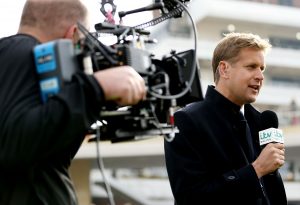You cannot exaggerate the importance of free-to-air television coverage to horseracing, said ROA President Nicholas Cooper in this magazine last month. He was referring to ITV’s return as British racing’s sole partner from January 1 and put special emphasis on the exposure the sport can expect to gain from a larger audience than Channel 4 provided.
He could just as pertinently have centred on the fact that the new four-year deal has cemented the principle of a media rights payment; only a decade ago racing was paying television for airtime.
Granted, the unconfirmed but unchallenged suggestion that the broadcaster will pay a total of £30 million over the period represents a tiny drip in the football ocean, where the Premier League recently pulled off a rise in its annual takeaway from China alone from £17.4m to £187.7m, but football lives in a world of its own.
Still, as the unpublished Frontier Economics report points out: “The growth of racing’s media revenues has been one of the successes of the last five years.” But has the rise and rise reached a plateau?

ITV gained the contract to broadcast terrestrial racing, taking over from Channel 4
The surprise pairing announced last summer between Racing UK’s parent company and SIS will bring together in 2018 what previously were warring parties, killing off one betting-shop channel, TurfTV, but prompting the creation of another, The Racing Partnership.
Video streaming is on the increase but faces stiff competition from other sports. Bookmakers have so far proved resilient to price rises, but with other pressures on the horizon, their uncompromising support may not last forever.
Here, as well as outlining the players and the figures, we gauge the media rights temperature among the three major elements – racecourses, broadcasters and bookmakers.
THE RACECOURSES
Change in the landscape of racecourses’ media rights is coming in stages. The deal with ITV starts on January 1; the betting-shop channel created by ARC will be cranked up a notch on the same day, but the once-unlikely marriage between RMG and SIS will not be consummated until April 2018. Some, but not all, are driven by increasing revenues.
The switch from Channel 4 to ITV, for example, was predicated on reaching and engaging with a larger audience, according to Jockey Club Chief Executive Simon Bazalgette, an influential member of the negotiating team.
“Payment is not the real issue,” he said. “It’s the coverage and the engagement, the audience and the ability to engage the audience. ITV pitched a story which convinced us they would be able to do that better than anyone else, and they put a bit more money on the table.
“Had we been in the position where they offered less money but pitched the same story, we would have had to balance things, but luckily we didn’t have to do that. In the end a couple of million pounds here or there didn’t matter. Making more money is fine in the short term, but in the long term this is about getting more people interested in racing.”
By contrast, RMG’s hammering out a contract for betting-shop picture rights with SIS, and effectively sounding the death knell for its own channel TurfTV, was about money. Rather the money that racing believed was being denied the sport by dividends siphoned off to outside interests, such as those that owned shares in SIS or TurfTV, and by duplication.
The new deal, which is understood to have been underwritten by the major bookmaking companies and offers protection for the smaller independents, will trim SIS’s earning potential while providing mechanics to enable racing to incentivise racecourses to drive value for betting.
Bazalgette explained: “We have genuinely done the deal to get the leakage out and make sure that although racing gets more money, the bookmakers should be able to pay less.
“It’s also worth saying that racecourses have become much more focused on driving the betting value of our product, because we’re getting significant revenues from betting operators. We recognise its importance and are putting pressure on ourselves to deliver better value to the bookmakers. That’s built into the SIS deal, since it’s a per-fixture fee linked to performance, in which field sizes have a pretty strong correlation.”
Whatever the changes in implementation, the importance of media rights to racecourses, big and small, cannot be underestimated.
Bazalgette said: “If managed properly media rights can help align the interests of the betting industry and our customers and generate interest in the sport. It’s not all about revenues, but media rights still represent probably our biggest revenue stream.”
Size varies, as does relationship to annual turnover. Newbury Chief Executive Julian Thick pointed to his company’s latest annual accounts, which showed that in the year to December 31, 2015 media revenues rose by £300,000 to £3.14m and represented 22% of revenue, while his Beverley counterpart Sally Iggulden had no hesitation in saying: “Media rights are now the most important part of our revenue stream, because the levy is a drop in the ocean, a top-up to prize-money.”
All three executives agree, though, that the joined-up approach is best, with Thick commenting: “Media rights are a very important asset for a business like ours; having them in a professionally managed collective is the best way to maximise their value. The different ways that people connect to racing means that the landscape is changing very quickly, particularly with streaming and bet-to-view products, therefore we need to pool the rights to make the most of them.”
Iggulden added: “The collective approach is the most vital. Of course there are challenges, but the industry needs first to preserve its media rights and then to grow them.”
And Bazalgette summed matters up: “There’s no doubt whatsoever that aggregated rights are best. A sport working together always performs better than one that doesn’t.”
THE BROADCASTERS
While the days of British racing’s being able to support more than one trade daily newspaper are long gone, two dedicated television channels for the sport are here to stay.
That’s the view of Richard FitzGerald, Chief Executive of Racecourse Media Group, the parent company of Racing UK, who commented: “Our business models are different – RMG is subscription, while ATR is more of a bookmaker product – and there’s just too much content for one channel.
“Given the strength of competition, we’re complementary not confrontational, and through GBI’s international business we have shown we can work well together. Overseas bookmakers and their customers don’t want to buy from different suppliers.”
Media rights can help align the interests of the betting industry and our customers
Both operators are rewarding their racecourse partners handsomely, and FitzGerald gives a pat on the back to the tracks themselves. “They own the rights and have organised themselves very well with a professionalised business model to provide a compelling proposition, and have taken control of the commercialisation of the rights,” he said.
Looking ahead, he added: “One of the challenges comes through social media. We have to be careful that we have something to sell, and new-fangled technologies have to drive long-term revenues. A recent report in the Financial Times said that millennials are already getting bored of social media, so we have to make sure not to undermine those revenues.
“It’s a very competitive market place and we now have more international racing coming into the UK. Also, we are competing with other sports that before the internet had very little appeal to punters. Golf, tennis and football, for instance, all offer a lot of opportunities for in-play betting, so we have to make the racing product better.”
FitzGerald’s counterpart at ATR, Matthew Imi, is preparing to hand over record levels of media rights income for 2016 to the company’s racecourse partners from distribution across more platforms at home and abroad than ever.
He said: “The brand goes from strength to strength and our broadcast and online audience continues to grow. What is particularly pleasing is that our level of engagement with that elusive audience, the 18-24 demographic, ranks highest amongst other racing media brands in the UK and is poised to grow further.
“Whilst there are clearly challenges going forward, we remain very positive about our ability to maximise the value of our racecourse partners’ media rights.
“We see technology and taking a global view at the heart of this and are well positioned to take advantage of any streaming, social media or over-the-top content opportunities, as and when they arise, because we own our own streaming platform.
“Whilst we operate in a competitive market worldwide with other sports trying to take market share from us, we believe horseracing remains a compelling betting product and perhaps the greatest challenge remains one of judgement – of all the opportunities out there in the global market, which ones should we pursue?”
THE BOOKMAKERS
The betting industry remains by far the biggest contributor to British racing’s media rights income, yet operators large and small argue that increased payments have come against a background of falling gross win from the sport.
Early in 2016, when the debate about the BHA’s authorised betting partner scheme was at its height, Gala Coral Chief Executive Carl Leaver released figures to show that over the previous seven years, his company’s costs on UK racing, including levy, media rights, sponsorship and online streaming, had increased by 45%, from £33m to £48m, while in the same period gross win from the sport, including from online business, had gone down by 19%, from £152m to £124m.
Among the direct costs he outlined, media rights and streaming had gone up from £17m in 2008, when TurfTV entered the market, to £35m in 2015, whereas the profit contribution of UK racing before operating costs had declined from £96m to £58m.

Carl Leaver, pictured with Ladbrokes’ Jim Mullen, says racing is a declining product
Leaver, who has since become Executive Deputy Chairman of the expanded Ladbrokes Coral Group, added: “Looking at retail only, the costs of UK horseracing account for more than half [54%] of Coral’s gross win after tax, up from 26% seven years ago. Indeed, this cost burden now means that over 200 Coral shops make a loss on UK horseracing before any allocation of shop operating costs, such as payroll, rent and rates, and central overheads.”
Coming up to date, the merger of the two majors will only partly redress the imbalance, according to Mark Chambers, Chief Operating Officer for the Coral retail division, who said: “The big challenge is that racing’s gross win from betting continues in long-term decline but racing’s operators are looking for substantial hikes in media payments, such as through the new ARC deal and for video streaming.
“Coral are paying at least £35m in media costs and around £12m in levy, so that will be more than double for the new group, £100m-plus in total, for a declining product.”
The situation is proportionately worse for smaller independent bookmakers, as Howard Chisholm, who operates 47 shops in the north of England and has already removed TurfTV from two, pointed out.
“The levy is proportional, media rights are not,” he said. “You pay out a chunk of money for media rights, which is easier for the big, city-centre shops to cope with, not the smaller independents.”
Chisholm, who traded without TurfTV for five years until SIS dropped full audio commentary facilities and he was forced to fall in line with larger competitors, added: “We now have to win £102 per day from every customer group in order to pay SIS and TurfTV, as well as betting duty, which adds up to £35,000 a year.
“Media costs per shop have more than doubled since TurfTV was introduced – from £12,286, including VAT, in 2007 to £31,946 in 2016 – which is why the independent sector has declined so much. And yet the vast majority of small bookmakers are still pro-racing, so they would go to the wall before they ditched a service. I don’t know how long that can continue.”



